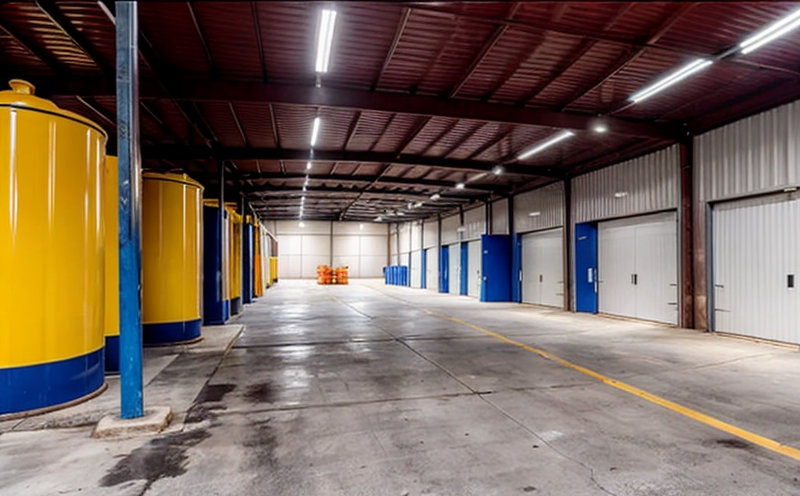Chemical storage warehouse inspection
The chemical storage warehouse inspection is a critical service that ensures compliance with international standards and local regulations to prevent hazardous accidents. This inspection involves evaluating the structural integrity, environmental controls, and operational procedures of facilities where chemicals are stored.
A chemical storage warehouse typically houses a variety of materials ranging from corrosive acids and caustic bases to flammable liquids and gases. Proper handling and storage are paramount for safety reasons, especially in environments where incompatible substances may come into contact with one another or be exposed to adverse conditions such as heat or light.
The primary goal of this inspection is to identify potential risks associated with the storage practices and mitigate them through recommendations tailored specifically for each facility. Compliance officers responsible for ensuring regulatory adherence can rely on these inspections to maintain a safe working environment.
During an inspection, experts assess various aspects including but not limited to:
- The physical condition of the building itself
- Environmental controls such as temperature and humidity levels
- Proper segregation of incompatible chemicals
- Emergency response protocols in place
- PPE availability and training for personnel involved
The inspection process also includes reviewing documentation related to the storage practices, including records of incoming and outgoing materials. This thorough examination aims at fostering a culture of continuous improvement within facilities.
A well-executed chemical storage warehouse inspection not only helps in preventing accidents but also enhances overall operational efficiency by highlighting areas where improvements can be made. For instance, it might suggest better organization methods or more efficient use of space which could lead to cost savings over time.
In summary, the importance of this service cannot be overstated given its direct impact on public safety and business continuity. By adhering strictly to best practices outlined during these inspections, organizations can ensure they are meeting both internal expectations as well as external requirements set by governing bodies around the world.
Scope and Methodology
The scope of a chemical storage warehouse inspection encompasses multiple facets that collectively contribute to establishing safe practices for handling hazardous materials. The methodology employed involves several key steps designed to comprehensively evaluate all relevant factors:
- Initial Assessment: This begins with an overview of the facility’s design, including structural elements like walls and floors, as well as any architectural features that could affect ventilation or fire safety.
- Environmental Controls Evaluation: Temperature sensors, humidity meters, and other monitoring devices are checked to ensure they function correctly. Proper airflow management is also assessed to prevent the buildup of volatile compounds.
- Incompatibility Checks: A detailed inventory of stored chemicals reveals whether there’s any risk from proximity between different types. This includes checking labels for compatibility codes provided by manufacturers.
- Emergency Procedures Review: Protocols for dealing with spills, leaks, or fires are scrutinized to identify gaps or areas needing improvement. Fire extinguishers and other safety equipment must be present and operational.
In addition to physical checks, documentation plays a crucial role in this process. Records of previous inspections, training sessions conducted for staff, and maintenance logs provide valuable insights into the facility’s past performance. These documents help establish trends over time which can inform future improvements or corrective actions needed immediately.
The inspection team uses industry-standard tools such as thermometers, hygrometers, and fire extinguisher testers to measure critical parameters accurately. They also employ visual observation techniques supplemented by digital photography where necessary to document findings clearly.
Customer Impact and Satisfaction
- Enhanced Safety: By addressing potential hazards early on, the inspection ensures that accidents are prevented before they occur. This peace of mind allows customers to focus on their core business activities without worrying about safety lapses.
- Better Compliance: Ensuring adherence to all applicable laws and regulations not only helps avoid legal issues but also maintains good standing with relevant authorities, enhancing the reputation of both the inspected facility and its clients.
- Increased Efficiency: Recommendations aimed at optimizing space utilization or streamlining processes can lead to significant cost savings. For instance, better organization reduces search times for specific chemicals during production runs.
A satisfied customer is one who knows they are operating safely within regulated parameters while achieving optimal productivity levels. Regular inspections form part of this ongoing commitment towards excellence, ensuring that even minor issues do not go unnoticed and receive prompt attention.
International Acceptance and Recognition
The chemical storage warehouse inspection is widely accepted across various regions globally due to its alignment with international standards such as ISO 14001 for environmental management systems, OSHA regulations in North America, and EN 54-6:2013 for fire safety. Adherence to these guidelines ensures that inspections meet the highest levels of acceptance internationally.
ISO 14001 emphasizes continuous improvement through monitoring performance metrics related to waste generation, resource efficiency, and pollution prevention. It provides a framework for integrating environmental considerations into business operations seamlessly. For chemical storage warehouses, this means minimizing environmental impacts by proper segregation practices and efficient inventory management.
In North America, the Occupational Safety and Health Administration (OSHA) sets strict rules about how hazardous substances should be handled safely. These include requirements regarding personal protective equipment (PPE), emergency response training, and facility design elements like clear signage indicating dangerous areas. Compliance with OSHA standards reassures customers that their suppliers are prioritizing worker safety above all else.
The European Union’s standard EN 54-6:2013 specifies minimum performance requirements for fire detection and alarm systems. It ensures that early warning systems are installed correctly to alert personnel promptly when fires break out. This timely notification gives enough time to evacuate safely, reducing risk significantly.
Recognition from these bodies underscores the importance placed on thorough inspections within chemical storage facilities worldwide. By meeting these stringent criteria, operators demonstrate their commitment to excellence and reliability, thereby building trust with stakeholders locally and internationally.





